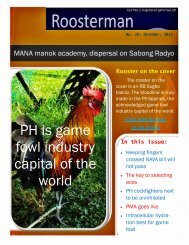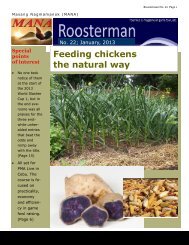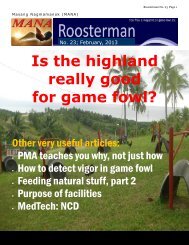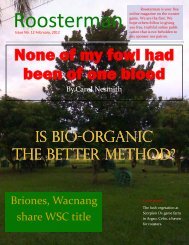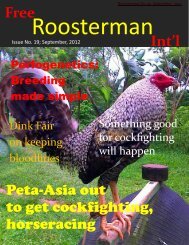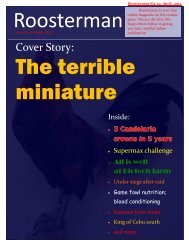Roosterman No. 11
Roosterman No. 11
Roosterman No. 11
- No tags were found...
Create successful ePaper yourself
Turn your PDF publications into a flip-book with our unique Google optimized e-Paper software.
Money Making idea<strong>Roosterman</strong> <strong>No</strong>. <strong>11</strong>; January, 2012Improving Native ChickenT he project entitled“Improving Household Welfarein Rakai District by ImprovingIndigenous Chicken Productionthrough Programmed Hatchingand Cockerel Exchange Program”ran from May 2003- April2005 and a consolidation phasegranted in 2006 for one year.The overall objective of the projectwas to contribute to povertyalleviation among the subsistencefarmers, especiallywomen and orphanage farmersin 2 sub Counties of Lwandaand Ddwaniro in Rakai District.The project was implementedby community integrated DevelopmentInitiatives ( CIDI) in collaboration withMakerere University, INCHORET, and St Jude’s, localgovernment with funding from FARM-Africathrough the Maendeleo Agriculture TechnologyFund.The project targeted 400 resource poor direct beneficiaries,organized into 20 groups and trained inmodern poultry management practices.CIDI worked with her partners and communityfarmers and have managed to improve upon localchicken through the technology of programmedhatching of local chicks, improved cockerel exchangeand selective breeding and better management.The programmed hatching technology synchronizesbirds to hatch on a particular day of the week.This is vital for quick multiplication of birds as wellas facilitating their management. The Programmedhatching was coupled with selective breeding of indigenouschicken that were improved upon by simplecross breeding with improved commercial cockerelsfor meat or eggs.First, selected Indigenous hens were crossed withimproved layer cocks to produce Rakai line 1 (R1)that were good egg producers.These were crossed with improved commercialbroiler cocks to produce an R2 line which were bothgood egg and meat producers. The R2 hens werecrossed with selected indigenous cocks to producean R3 line. This is expected to be a more stable birdthat is resistant to diseases, yet a high yielding dualpurposebird called the “Rakai chicken”.The farmers were trained in good poultry husbandrypractices such as brooding techniques, nutrition,housing and disease control and capacity buildingfor farmers groups to undertake their developments.The Rakai Chicken Breeders Association (RCBA)was formed by farmers to facilitate purchase andmixing of feeds, sales of eggs, and supply of otherinputs for poultry keeping at village level.22



